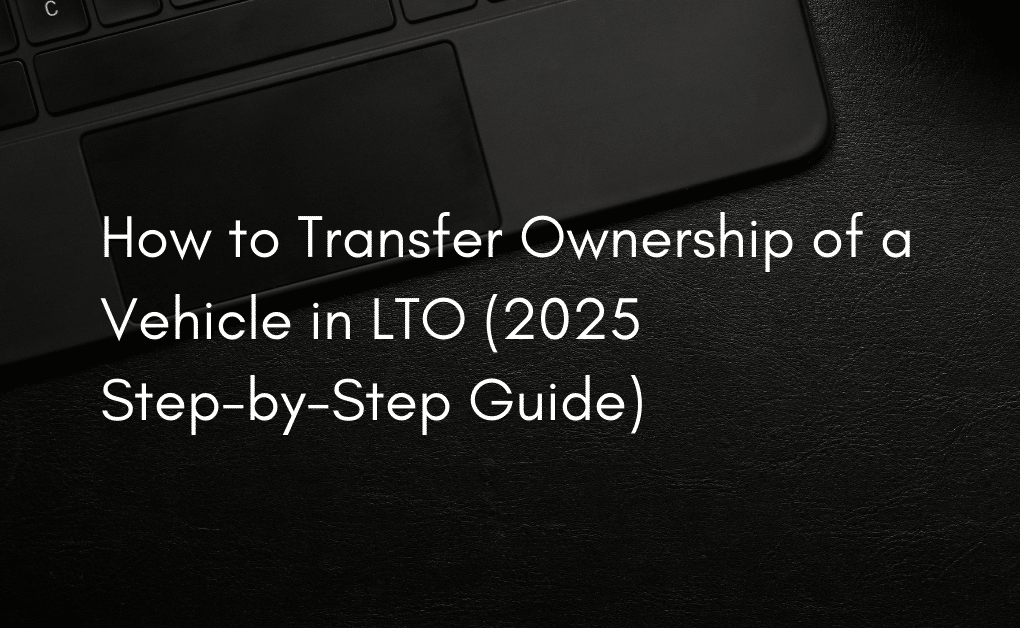Transferring vehicle ownership in the Philippines can feel overwhelming—especially with the required documents, LTO procedures, and inspection requirements. Whether you're buying or selling a second-hand car, it's crucial to follow the correct steps to avoid legal and financial issues down the road.
In this 2025 guide, we'll walk you through how to transfer ownership of a vehicle through the Land Transportation Office (LTO)—step-by-step.
Why It’s Important to Transfer Ownership
- The previous owner still appears in LTO records
- You may be liable for fines or violations you didn’t commit
- Delays in registration renewals
- Legal complications when selling the car later
By processing the change of ownership with LTO, you're protecting yourself legally and ensuring a clean vehicle record.
Who Should Process the Transfer?
- Buyer – Generally responsible for completing the LTO transfer.
- Seller – Must provide all required documents and assist in securing clearance (like the PNP-HPG clearance).
Tip: It's best if both parties are involved in the process to prevent missing requirements or disputes.
Step-by-Step Guide to Transfer Vehicle Ownership at LTO (2025)
Step 1: Secure the Required Documents
Here’s what you’ll need:
From the Seller:
- Original Certificate of Registration (CR)
- Latest Official Receipt (OR) of registration
- Original Deed of Sale (Notarized)
- Valid government-issued ID of the seller
From the Buyer:
- Photocopy of valid ID
- Taxpayer’s Identification Number (TIN)
- Insurance policy under buyer’s name
Additional Requirements:
- Emission Test Result
- Motor Vehicle Inspection Report (MVIR) from a private motor vehicle inspection center (PMVIC)
- HPG Clearance (from PNP – Highway Patrol Group)
✅ New in 2025: Some LTO offices now accept digital copies and online document submissions. Check with your local branch.
Step 2: Secure a PNP-HPG Clearance
Before any LTO transfer, you need clearance from the Philippine National Police – Highway Patrol Group.
How to get it:
- Go to your nearest HPG office.
- Submit:
- Notarized Deed of Sale
- CR and OR
- Valid IDs
- Have your vehicle inspected by HPG officers.
- Pay the processing fee (usually around PHP 500–700).
- Receive your HPG Clearance Certificate.
⚠️ Avoid fixers. Always go through official channels to ensure authenticity.
Step 3: Vehicle Inspection at PMVIC
You’ll need to undergo a Motor Vehicle Inspection:
- Book an appointment with an LTO-accredited PMVIC.
- Bring your vehicle for physical inspection.
- Get the MVIR and Emission Test Certificate.
- Pay the inspection and emission test fees (approx. PHP 900–1,500).
Step 4: Go to the LTO for Change of Ownership
Visit the LTO district office that handles your vehicle’s registration.
Submit the following:
- HPG Clearance
- Notarized Deed of Sale
- Original CR & latest OR
- Buyer and seller IDs
- Emission Test and MVIR
- Insurance (updated and under buyer's name)
- Other LTO forms (available at the office)
Step 5: Pay the Transfer Fees
Fees vary slightly by region and vehicle type, but expect:
| Fee Type | Estimated Cost (PHP) |
|---|---|
| Transfer of Ownership | 450–700 |
| Computer Fee | 169 |
| Inspection Fee | 90 |
| Emission Test (from PMVIC) | 500–800 |
| Total | ₱1,200 – ₱2,000+ |
Make sure to keep your official receipts as proof of payment.
Step 6: Wait for the New Certificate of Registration (CR)
Once everything is processed, the LTO will issue:
- A new Certificate of Registration under the buyer’s name
- An updated Official Receipt
- Your license plates will remain the same unless updated as part of a reclassification or other changes
📌 Processing time: Usually 1–2 business days if all documents are complete.
Optional: LTO Online Appointment System
To save time, you can book an LTO appointment online through the Land Transportation Management System (LTMS).
Steps:
- Register and log in at portal.lto.gov.ph
- Click on "Appointments" and choose a service
- Select "Transfer of Ownership"
- Pick your preferred LTO branch and date
- Bring the appointment slip to your scheduled visit
Note: Not all LTO branches accept online appointments for this service—call ahead to confirm.
Common Mistakes to Avoid
- Not notarizing the Deed of Sale
- Missing the TIN of the buyer (required even if not employed)
- Skipping HPG clearance
- Processing transfer too late (fines may apply after 30 days)
- Buying from a seller who doesn’t have complete documents
Frequently Asked Questions (FAQ)
Q: Can I transfer ownership without the original CR?
A: No. The original Certificate of Registration is mandatory. You must request a duplicate from LTO if it’s lost.
Q: How long do I have to transfer ownership?
A: Within 30 calendar days from the date on the notarized Deed of Sale. Late processing may incur penalties.
Q: Do I need to be physically present at LTO?
A: Ideally yes, but authorized representatives can process it with a notarized Special Power of Attorney (SPA).
Q: What if the car still has a loan?
A: The transfer can't proceed until the encumbrance is cleared and the vehicle is fully paid.
Q: Is the transfer process the same for motorcycles?
A: Yes, though fees may be lower. Documents and steps are generally the same.

